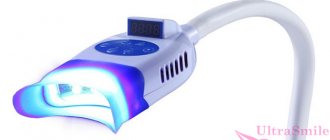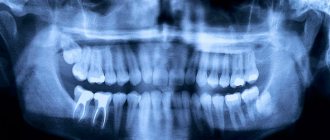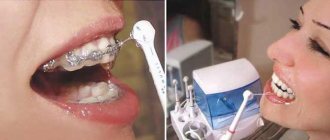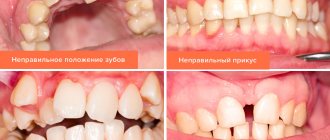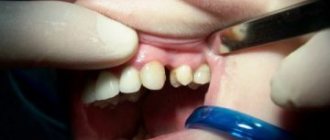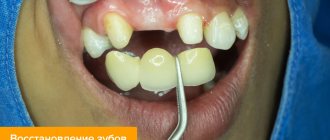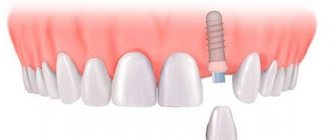Polyodontia is an abnormal number of teeth.
In medicine, this disease is often called hyperdontia, and “extra” dental elements are called supernumerary teeth. Research is still being conducted into why this pathology occurs. Most scientists associate it with disturbances in the formation of tooth germs.
Nature provides that a person grows no more than 20 milk teeth and 32 permanent teeth in a lifetime, but exceptions occur, and in our time quite often. According to statistics, on average, dental anomalies occur in 2% of the world's population, most often in men.
In 2014 alone, two operations were performed, in one of which 80 teeth were removed, and in the other, a record 232 teeth. Until this time, the maximum figure was 37 teeth.
The most common hyperdontia (anomaly in the number of teeth) is an anomaly of the upper incisors. Supernumerary teeth are less common among the lower incisors and in other parts of the jaw. They can come in a wide variety of shapes and sizes. These are usually small, cone-shaped teeth.
Extra teeth lead to deformation of the dentition, so it is recommended to remove supernumerary elements. Another reason for removal is that most patients with this pathology have a lisp.
The formation of extra teeth is quite common today. According to statistics, 70% of patients have only one extra incisor, in 25% of cases – 2 supernumerary elements, and only 5% of all patients have 3 or more teeth during examination.
Other treatments
| Another way to solve the problem is orthodontic treatment. This is true if the abnormal unit is located close to the dentition. Braces are usually used to straighten it, since this method is the most effective. The duration of treatment is determined individually, depending on individual characteristics. Orthodontic treatment may also be prescribed after the removal of a supernumerary tooth in order to normalize the bite. |
Causes of polyodontia
Medicine has not yet found an exact answer to the question of what are the causes of supernumerary teeth. Scientists put forward several hypotheses:
- Atavism. Supernumerary teeth are explained by the fact that the dental system strives to return to the original number of elements laid down by nature. There is evidence that our ancestors had 6 incisors on both the lower and upper jaws. As a result, many doctors consider atavism to be the cause of the development of polyodontia in humans.
- Splitting of the tooth germ. Even in the embryonic period, the activity of the dental plate is disrupted in the child, as a result of which hyperdontia is formed. Violations can be caused by viruses, poor ecology, drugs, medications prohibited during pregnancy, alcohol and other factors. This hypothesis is increasingly supported today, because recently the disease has been rapidly progressing due to bad habits and poor ecology.
The causes of hyperdontia continue to be researched. Scientists cannot give an exact explanation for this anomaly, but most of them are inclined to the second hypothesis - the splitting of the tooth germ at the embryonic stage.
Hyperdontia
Features of supernumerary teeth:
- Quantity
Most often a single tooth occurs (about 70% of cases of hyperdentia), but two, three or more are also described. Cases with the identification of 2 or more supernumerary teeth must be distinguished from odontoma - this is a benign tumor built from dentin and enamel, which in its structure may contain many deformed tooth germs.
A case is described in which over 200 small enamel drops were removed from an odontoma, but by their nature such teeth are not supernumerary;
- The bite in which they are revealed
More often - about 2/3 of cases - in the replacement (during the period of replacement of milk teeth with permanent ones), in adults in the permanent dentition - ¼ of cases, and only occasionally are supernumerary teeth found in children in the milk dentition, this is less than 6% of cases;
This is what supernumerary teeth look like
- Location in the dental arch
Almost always this is the upper jaw - between the central incisors (mesiodens), in the area of lateral incisors and canines, and occasionally - next to the molars. In the lower jaw, supernumerary teeth are detected only in 3% of cases, in any part of the lower dental arch;
- Growth direction
Correct eruption (appearing outward) is on the crest of the jaw arch in the dentition.
But in the case of hyperdentia, deviations are possible due to lack of space. Therefore, the direction of growth can be any - towards the palate, tongue, vestibular (outward). There are cases of deep burial in the thickness of the jaw, and eruption is impossible;
- Anatomical shape
Anomalies such as spiky, chisel-shaped, triangular or lumpy deformities are not uncommon;
What does polyodontia look like?
Quite often, extra teeth are almost indistinguishable from normal ones. It is not uncommon for them to grow in the form of a drop or a thorn. These dental elements can appear either individually or fused with permanent ones. They can form tooth-like formations and entire arrays of teeth.
Also in medical practice, there are cases where polyodontia was hidden and was detected only by radiography. There are many different cases of abnormal development of the number of teeth, and if you notice symptoms, you should definitely contact the dentist.
Types of polyodontia disease
Polyodontia in the oral cavity manifests itself in different ways. By studying the statistics, signs and symptoms of the disease, dentists were able to classify the types of this anomaly.
Depending on the origin, the disease is divided into two types:
- False polyodontia. Provides for a baby tooth that does not fall out, regardless of the person’s age. At the same time, it fulfills its functions, does not create discomfort to the bite, and is firmly fixed in the patient’s jaw. In addition, teeth fused together and other anomalies are classified as a false type of disease.
- True polyodontia. It can be caused by genetic predisposition, as well as terogenic factors. At the same time, extra molars begin to form in the human jaw.
Types of pathology
Depending on the origin of the anomaly, there are 2 types of pathology:
- False . A baby tooth is formed, which, unlike ordinary ones, does not fall out. In this case, the pathological neoplasm is firmly fixed in the jaw, does not cause discomfort and performs the normal functions of the tooth.
- True . The pathology is caused by teratogenic factors and hereditary predisposition. A person has formed molars that are superfluous.
According to clinical data, false polyodontia (baby teeth that do not fall out) is found even in elderly patients (60-70 years old). In this case, the anomaly was detected by chance, and the patient’s “extra” teeth did not cause discomfort or deformation of the dentition.
Polyodontia is also divided into 2 types according to the form of placement of supernumerary teeth:
- Typical. The typical form of polyodontia is formed directly in the dentition and does not extend beyond it. At the same time, a person with such an anomaly perceives the appearance of extra teeth as a hereditary feature or a more developed jaw, compared to ordinary people.
- Atypical. A rarer form of pathology, which is characterized by the appearance of supernumerary teeth outside the dentition.
Experts say that formed baby supernumerary teeth do not pose a particular threat to human health. But permanent, molar abnormal teeth must be removed without fail!
As for the placement of extra teeth, dentists distinguish the following types of disease:
- Typical hyperdontia. Applies to those patients in whom extra teeth appear only in the dentition and do not extend beyond it. Many scientists are confident that this is simply heredity, because our ancestors had a more developed dental system than modern people.
- Atypical hyperdontia. It occurs much less frequently and is characterized by the appearance of teeth outside the dentition.
In case of anomalies with baby teeth, the latter pose almost no threat. On the contrary, such a tooth can last a lifetime. But the permanent molars, over which the supernumeraries grow, should be removed, if only because it is not aesthetically pleasing.
Often, the patient grows extra fangs or incisors, or even several front teeth at once. In addition to a ruined smile, the disease can cause serious complications if the necessary measures are not taken in time.
Treatment
It does not always involve removing a supernumerary tooth. There are three tactics:
- Leave it lying
- Place in the dentition
- Delete
If the supernumerary tooth lies deep, does not bother you, and can only be reached in a rather traumatic way, then it is better not to touch it. Orthodontic treatment is carried out both before and after removal. In some cases, it is possible to place an extra tooth in the bite. For example, the main incisor is depulped due to arsenic periodontitis and has changed color. Then the surgeon gets rid of the permanent incisor, and the orthodontist installs an extra one in a row using braces, and later removable or fixed retainers. If the new tooth has pushed the neighbors, then you need to return everything to its usual position, for which the permanent edgewise technique (bracket system) is again used in adults. In children, it is possible to correct the anomaly using devices and removable elements due to jaw growth.
If a supernumerary tooth causes pain in a child, you can take the following remedies:
- Ibuprofen and paracetamol to relieve symptoms of fever and inflammation. It is best not in tablets, but in the form of suppositories for the little ones, this is how the drug works most effectively
- Teething gels: Dentinox, Kalgel, Baby Doctor
- For older people, including adults, you can rinse your mouth with decoctions of sage, chamomile, oak bark, and propolis to relieve pain.
Symptoms of the disease in children
The first supernumerary teeth in children appear before birth or in the first six months of life. The main inconvenience they cause is difficulty in feeding.
Polyodontia of primary teeth in older children occurs with symptoms similar to the eruption of regular teeth. In this case it is observed:
- temperature increase;
- swelling of the gums in the place where the tooth should erupt;
- pain;
- excessive salivation;
- swelling of the nasal mucosa;
- loose stool.
Symptoms are especially severe when extra teeth appear in the upper palate.
If hyperdontia makes itself felt in a two-year-old child, this can interfere with the formation of normal speech. In turn, due to injury to the tongue and mucous membranes, some kind of inflammation constantly appears in the oral cavity.
When supernumerary teeth appear in very noticeable places in school-age children, ridicule towards the patient may occur, which is fraught with the development of psychological problems and complexes in the future.
Symptoms in adults and children
Hyperdontia may not bother a person at all and may not cause him any inconvenience. This anomaly manifests itself differently in adults and children.
Adults may experience the following symptoms:
- disorders of chewing function;
- problems with the digestive system;
- speech defects;
- frequent inflammatory processes on the gums;
- jaw deformation, pain;
- loosening of neighboring teeth, their curvature.
In addition, there is a psychological factor. Often, pathology leads to a person’s complexes and lack of self-confidence, especially if the extra tooth is visible to others. The solution to this problem is to remove it.
If supernumerary teeth erupt in infants, the symptoms are similar to the eruption of regular teeth:
- excessive salivation;
- increased body temperature;
- redness of the gums;
- swelling of the nasal mucosa.
However, with the appearance of pathological teeth, all symptoms may intensify. There may also be problems during breastfeeding. The baby may not latch onto the breast correctly, which can lead to cracks and painful feeding.
In older children who are replacing their baby teeth with permanent ones, the symptoms are similar to adults. Often, due to hyperdontia, children develop an incorrect bite. Also, supernumerary teeth can interfere with the formation of speech and the correct pronunciation of individual sounds. In some cases, there is a delay in the eruption of permanent teeth when the milk teeth have already fallen out.
Symptoms of hyperdontia in adults
Polyodontia affects permanent teeth more often than baby teeth. An adult usually develops dystopic and impacted supernumerary teeth.
Dystopic teeth are those that appear outside the dental arch. Most often they erupt on the lingual surface of the gums and in the palate. With this form of the disease, the patient typically:
- poor pronunciation of sounds;
- noticeable malocclusion;
- change in the usual arrangement of teeth: curvature of the angle at which they grow, as well as their rotation
- around its axis;
- frequent injury to the oral mucosa and, as a result, its inflammation;
- disruption of chewing processes, resulting in digestive problems.
Among other things, dystopic teeth often cause psychological problems. Due to a non-aesthetic, and sometimes completely unattractive smile, the patient becomes withdrawn and uncommunicative. Psychological problems, in turn, cause chronic diseases of the endocrine, digestive and nervous systems.
Impacted supernumerary teeth are teeth that do not erupt, but continue to remain in the bone tissue of the human jaw. Often they hardly make themselves felt until complications begin. Dentists diagnose this anomaly during a routine examination of the patient.
This abnormality in the number of teeth is accompanied by the following symptoms:
- normal teeth begin to loosen (the condition is considered pathological);
- the bone begins to protrude (if the impacted tooth is too close to the edge of the jaw);
- Aching pains appear periodically.
One of the most difficult situations is when extra teeth grow in place of impacted third molars. Wisdom teeth cannot grow and begin to negatively affect the roots of other teeth, which in turn can lead to serious complications.
Symptoms
Symptoms of the disease may differ between adults and children. Let us first consider the signs of this pathology in children and adolescents:
- A sharp increase in body temperature.
- Decreased appetite, problems with breastfeeding.
- Swelling of the gums and/or nasal mucosa.
- Pain.
- Increased salivation volumes.
- Diarrhea.
Symptoms are most pronounced during the eruption of supernumerary teeth on the upper palate.
Permanent teeth are more often affected by polyodontia. As a rule, we are talking about the eruption of dystopic and impacted extra teeth. Dystopic ones usually erupt outside the dental arch - usually on the lingual gingival surface or palate. Symptoms:
- Broken bite.
- Incorrect pronunciation of basic sounds (even though there were no problems before).
- Changing the order of teeth.
- Injury to the mucous membranes of the mouth, possible development of traumatic stomatitis.
- Chewing problems and gastrointestinal problems.
Impacted teeth do not erupt completely, that is, they remain in the bone tissue. Until complications such as swelling, suppuration or dental abscess develop, they usually do not make themselves felt. The anomaly is diagnosed as part of routine dental examinations. Symptoms in this case:
- Normal teeth become loose.
- The bone sticks out.
- Worried about aching pain.
One of the most difficult situations in dental practice is when supernumerary teeth grow in place of impacted third molars.
Consequences of polyodontia disease
Polyodontia in humans can often be the cause of retention. This is a phenomenon in which normal teeth are unable to erupt due to the interference of supernumerary teeth. The former may remain in the jaw or take an abnormal position.
In addition, even if the complete incisor grows before the supernumerary one, the latter will be able to displace it. This will lead to the person being unable to chew food normally. And if several extra incisors grow at once, they can cause the loss of permanent teeth.
Diagnostics
Examining supernumerary teeth during an x-ray is not as easy as it seems. They can be superimposed along the contour onto the permanent ones and remain invisible. In such cases, patients are recommended to undergo a computed tomography scan, which shows a more accurate picture of the disease.
If the extra dental elements have already erupted, the dentist can easily detect them. In practice, the patients themselves find the erupted supernumerary teeth and already at the initial appointment with the dentist they complain about the pathology.
In what cases is it necessary to remove supernumerary teeth?
Removal of supernumerary teeth is recommended in 90% of cases. You can refuse surgical intervention in the following cases:
Simply put, if a supernumerary tooth causes inconvenience, pain or discomfort, it is removed. |
Symptom relief
Most often, in adults, extra teeth erupt without any symptoms, but for children this can become a problem that needs to be addressed.
Supernumerary teeth erupt with the same symptoms as regular teeth, so the treatment for them is the same.
- To lower the temperature, it is recommended to give your baby Paracetamol or Ibuprofen. If the child is very small, these drugs can be used in the form of suspensions or rectal suppositories. In addition to lowering the temperature, these medications do an excellent job of treating pain and inflammation.
- To relieve gum pain, local anesthetics are used - ointments and gels (for example, Kalgel, Dentinox, Solokoseryl). These remedies cope well with painful sensations and slightly relieve inflammation.
- Adults and children over 2 years of age can be treated with folk remedies: propolis, honey, decoctions of calendula, chamomile and lemon balm. Some decoctions help reduce pain and relieve inflammation. Traditional methods of treatment should be used only after consultation with your doctor.
- If primary supernumerary teeth have partially erupted, stimulation of eruption is prescribed. For this purpose, vibration and electrical stimulation, as well as special massage, are used.
How to make it easier to cut through extra units
In young children, the period of teething may be asymptomatic. But in case of discomfort and pain in children and adults, the following can be used to alleviate the condition:
- Painkillers. Paracetamol or Ibuprofen will help relieve pain. For children, it is recommended to use drugs in the form of suppositories or syrup.
- Local agents. Dentinox or Solocoseryl are used, which help not only relieve pain, but also inflammation.
- Traditional methods. To eliminate unpleasant sensations during teething in children over 2 years old, use a solution based on chamomile, calendula or lemon balm. They are used for rinsing. Thanks to the special properties of plants, it is possible to get rid of pain and inflammation.
Normal deletion
If the dentist decides that in a particular case, polyodontia can only be treated by removing an extra tooth, the patient should count on the following procedures:
- First of all, the patient should be sent for radiography. This is necessary in order to determine the size and number of roots, as well as the ratio of supernumerary and normal teeth.
- After collecting research, the doctor gives the patient anesthesia and removes excess teeth.
- In some cases, soft tissue sutures may be necessary after surgery.
Removal of impacted teeth
In order for the operation to be successful and polyodontia to be cured without any complications, the doctor must fully examine the patient and plan his further actions.
- To begin with, X-rays and/or computed tomography are performed to determine the exact topography of the anomaly.
- Removal is performed under local anesthesia, but there are cases when general anesthesia can be used on the patient.
- First, the mucous membrane is peeled off, then the bone tissue is opened and the root and crown parts of the tooth are removed.
- If necessary, bone defects are covered with osteoplastic material, and the mucous membrane is sutured.
After tooth extraction, the patient continues treatment at home: takes antibiotics (if prescribed by the attending physician), rinses the oral cavity with antiseptic solutions.
Until the wound heals after surgery, it is not recommended to eat too hot, hard or spicy food. You should also brush your teeth carefully, especially on the operated side.
